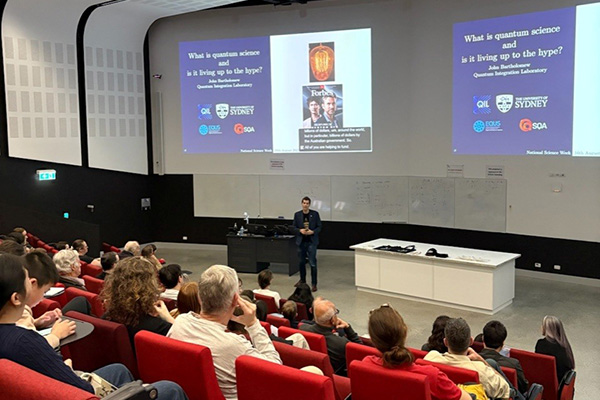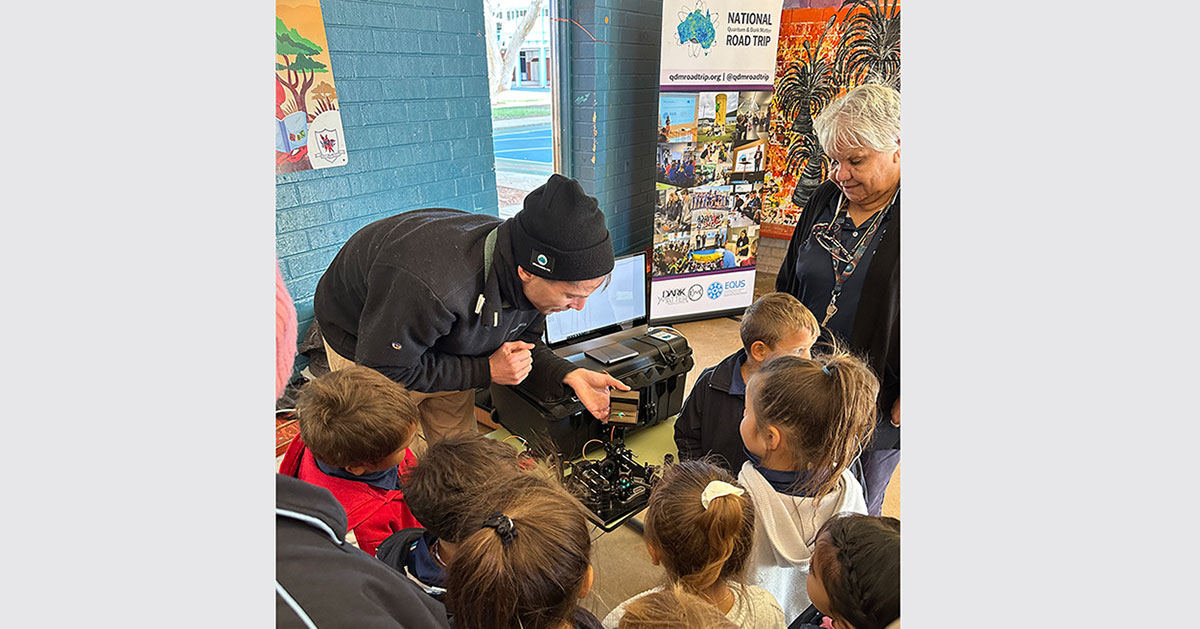In early August, three members of the Quantum Science Group – Dr Cyril Laplane and PhD students Maverick Millican and Yuktee Gupta – packed their bags and embarked on a road trip from Karratha to Perth, stopping off at remote communities, schools and youth centres to give science-themed talks and demonstrations.
So began the 2025 National Quantum and Dark Matter Road Trip, an annual program designed to bring quantum technology and particle physics to schools and communities that may not otherwise have access to such cutting-edge science, and to inspire regional and remote students to consider careers in science. As key organiser Dr Kristin Beer notes, students in remote and regional Australia are less likely to pursue a career in science – and the Road Trip aims to change that.
In addition to trivia nights and public talks, researchers demonstrated quantum technologies that are rarely seen outside research laboratories — let alone in outback classrooms. In one demonstration, Dr Cyril Laplane used a green laser and a pink diamond to reveal the red glow of quantum emitters — tiny defects in diamonds known as nitrogen vacancy centres. This demonstration shows how diamonds can detect magnetic fields with extraordinary sensitivity, showcasing a technology that may eventually replace MRI machines at a smaller and cheaper scale. Meanwhile, PhD researcher Maverick Millican used electric fields to trap fine red dust from the nearby desert — suspending it midair to illustrate how scientists trap individual atoms for quantum simulation and sensing. The same principle underpins the advanced quantum sensors used in the Quantum Control Laboratory. These tools, usually reserved for cutting-edge research laboratories, gave students a rare glimpse into the platforms driving Australia’s quantum future — a future they could one day help shape.
Whilst much of the Road Trip was spent in regional and rural areas, its organisers also held outreach events in capital cities, including a Quantum and Dark Matter Experience at the University of Sydney on 16 August 2025 that combined demonstrations, lab tours and a public talk. Co-hosted by the Quantum Science Group and catering to a large range of age groups (with the age of attendees ranging from 3 years old to over 80!), this immersive event aimed to demystify complex physics, spark interest in STEM, and make cutting-edge science feel accessible to young minds.
Attendees heard from the Quantum Science Group’s Dr John Bartholomew who – in a nod to the UN International Year of Quantum – gave a talk charting the evolution of quantum science over the past 100 years: from 19th century light bulbs through to Australia’s billion-dollar investment into quantum computing. He was later joined by PhD students Ben Field, Gargi Tyagi and Timothy Newman who took participants on a behind-the-scenes tour of the Quantum Integration Laboratory and who helped to deliver hands-on demonstrations that brought dark matter and quantum science to life.

Since 2022, the National Quantum and Dark Matter Road Trip has covered nearly 25,000 kilometres and brought quantum science and particle physics to some of farthest corners of Australia. And every year since 2022, members of the Quantum Science Group have participated in the Road Trip and its satellite events – a testament to the Group’s enduring commitment to making science inspiring and accessible, and to cultivating the next generation of scientists. This outreach is made possible thanks to the support of the Australian Government and Inspiring Australia, whose National Science Week grants have helped bring quantum technologies to curious minds and classrooms across the country.






